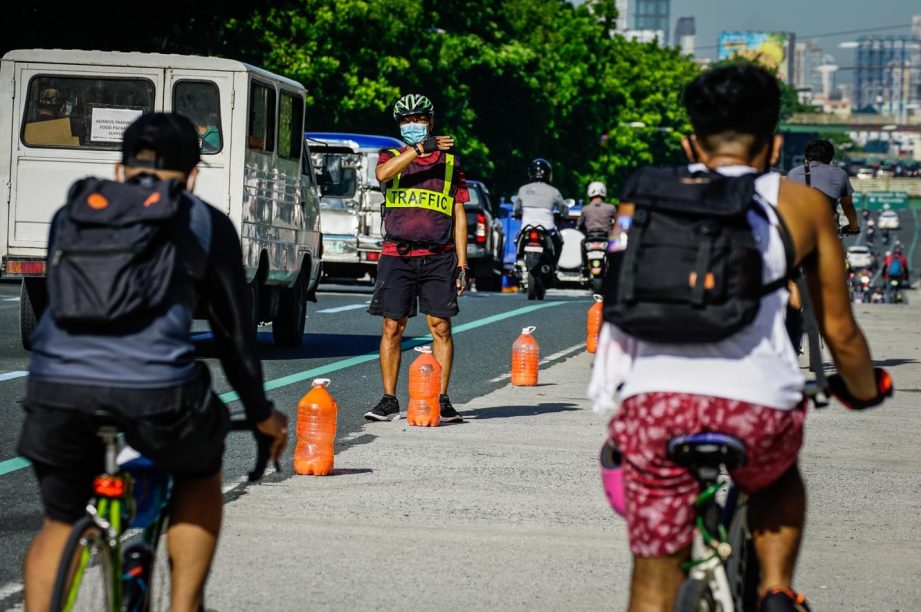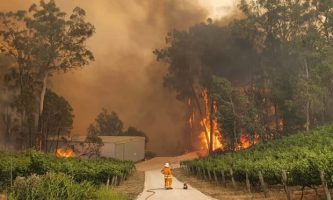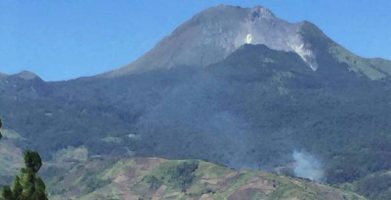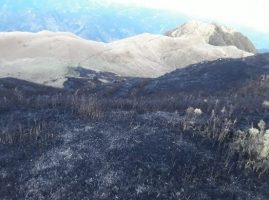Last September 10, residents of California cities, particularly San Francisco, Oakland and Berkeley beheld an eerie sight of orange skies. Such was the result of wildfires raging in the US West Coast, their smoke and ash blotting out sunlight and creating the rust-colored haze.
According to the California Department of Forestry and Fire Protection, the wildfires began as early as January, and have already burned down more than 3 million acres in the state. Since the increased fire activity last August 15, there have been 24 deaths and over 4,000 damaged structures. But outside these figures, the wildfires have wreaked havoc in the atmosphere, putting areas under Air Quality Indexes of “very unhealthy” and even “hazardous”, forcing residents to stay indoors.
 Orange-tinged skies in the Bay Area in San Francisco last Sept. 10 at 10:30 a.m. (photo by Irma Cruz-Dimaisip)
Orange-tinged skies in the Bay Area in San Francisco last Sept. 10 at 10:30 a.m. (photo by Irma Cruz-Dimaisip)
The Pollution Problem
Even without the wildfires, ambient air pollution is a global problem, causing over 4 million deaths each year. According to the Centre for Research on Energy and Clean Air, pollutants are linked to severe respiratory and heart diseases, and lowers resistance against airborne viruses, making one vulnerable during the COVID-19 pandemic.
According to the World Health Organization (WHO), these human activities are the major sources of outdoor pollution:
- Fuel combustion from motor vehicles (e.g. cars and heavy duty vehicles)
- Heat and power generation (e.g. oil and coal power plants and boilers)
- Industrial facilities (e.g. manufacturing factories, mines, and oil refineries)
- Municipal and agricultural waste sites and waste incineration/burning
- Residential cooking, heating, and lighting with polluting fuels
- Poor urban planning, which leads to over-dependence on private vehicles
Combustion engines, fossil fuels and industrial activities produce Particulate Matter (PM), which contains sulphate, nitrates, ammonia, sodium chloride, black carbon, mineral dust and water. Most dangerous is PM2.5, which has a diameter of less than 2.5 micrometers. Because of its tiny size, PM2.5 is easily inhaled, allowing it to penetrate the lungs and blood stream, causing illnesses, which may lead to premature death.
WHO data further states that more than 80% of people living in urban areas that monitor air pollution are exposed to air quality levels that exceed WHO guideline limits. The most affected countries with the greatest toll are in the Western Pacific— and Southeast Asia, which includes the Philippines.
 Aerial view of the Pasig River (photo by Enrico Empainado/Greenpeace)
Aerial view of the Pasig River (photo by Enrico Empainado/Greenpeace)
Metro Manila’s Alarming Air Quality
Greenpeace Philippines reported a dramatic improvement in air quality during the enhanced community quarantine (ECQ) in Metro Manila from March 15 to May 15, 2020. With this measure to curtail the spread of COVID-19, most of the National Capital Region’s 2.5 million vehicles were kept off the road, resulting in PM2.5 levels dropping by an astounding 180%.
But this improvement was short-lived. Since the region shifted to general community quarantine (GCQ) last June 1, smog and pollution levels continue to climb, slowly reverting to the poor air quality experienced before ECQ.
Prior to the lockdown last February, groups such as Greenpeace, Clean Air Asia and the Center for Energy, Ecology and Development (CEED), Health Care without Harm, the Philippine Movement for Climate Justice (PMCJ), and the World Wildlife Fund for Nature (WWF) Philippines had called on the government to overhaul its monitoring and analysis of air pollution data to provide more accurate information. This was in response to the recent 2019 Air Visual report, which placed the Philippines in the 58th spot out of 98 countries. The groups argued that though the country’s ranking wasn’t high, data still showed that the country’s air quality was getting worse. In 2018, the country’s air pollution level of 17.6 micrograms per cubic meter was well beyond WHO’s safety limit of 10 micrograms per cubic meter.
 Bikers during ECQ (photo by Jire Carreon)
Bikers during ECQ (photo by Jire Carreon)
A Greenpeace Philippines report released in February, showed that toxic emissions could cost Filipinos as much as a 1.9% loss in Gross Domestic Product, as well as 27,000 premature deaths. For a clearer picture of the country’s air pollution, the groups urge the government to place monitoring stations near coal-driven power plants and areas of high traffic.
“The Philippine government should see the data as an impetus to overhaul air quality monitoring systems in the country, as well as to transition away from highly polluting facilities such as coal plants. Our safety standards for air pollution haven’t changed since 1999,” said Khevin Yu, campaigner of Greenpeace Philippines. “This situation has allowed industries and facilities to pollute the air we breathe with impunity.”
Meanwhile, Greenpeace campaigner Rhea Jane Pescador-Mallari believes that the ECQ showed Filipinos that healthy, clean air is possible in the metro. “Moving forward, if the government is willing to use the opportunities and lessons learned from the pandemic and amplify it through policies and infrastructure, active mobility and micro mobility, as well as invest in efficient and safe mass public transport, then a return to the massive pollution levels before COVID-19 can be avoided.”
Clean Air for All
The severity of recent global wildfires are fueled by climate change, which brings about soaring temperatures, drier conditions and pest outbreaks that weaken trees. According to WHO, air pollutants like black carbon and methane contribute to global warming and glacial melt. The Climate and Clean Air Coalition also states that air pollution threatens food and water supply by blocking sunlight, and affecting the movement and intensity of monsoons.
To secure the Filipinos’ health, Greenpeace Philippines advocates for the stricter implementation of the Clean Air Act, and the following measures:
- Maintaining flexible remote work arrangements or staggered work shifts, where possible
• People-centric urban design, where public spaces should be planned in parallel with the establishment of mobility programs
• Rebuilding trust in mass transit and supporting displaced transportation workers, possibly with LGU-centric green mobility services - Low-cost, active and carbon-neutral transport options that enable micro-mobility
• Tightening vehicle emission standards from Euro 2 to 4 to 6, and implementing accordingly
• Developing capabilities for real-time monitoring of dangerous pollutants in cities
• Strengthening industrial air pollution standards and wider adoption of renewable energy
Greenpeace believes that the efforts to solve air pollution are the same ones needed to mitigate the climate crisis. “As epicenters of growth, cities need to provide an environment that puts in high premium the health and wellness of both people and the planet. At the local level, addressing air pollution is a key aspect of making cities livable and sustainable. At the national level, it means addressing the climate crisis while helping build climate-resilient communities,” said Mallari.
A few months away from the start of a new decade, a wildfire started to raze the
northern part of Australia in September 2019. Today, it is now considered as one of
the most destructive bushfires that has ever hit Australia with more than 20 related
deaths and 1,300 houses destroyed, mainly in New South Wales.
Why do bushfires occur?
Summer in Australia is also known as fire season, which is associated with hot and
dry weather making it easier for blazes to start and spread.
There are different reasons why bushfires occur. Natural causes happen when
lightning strikes drought-affected forests. Another reason may be arson, which is
manmade.
In Australia’s case, strong winds made the fires and smoke spread rapidly. The
Climate Council stated that climate change has worsened the impact and intensity of
natural disasters, as in the case of Australia’s bushfires.
As of January 6, 2020, more than 5.9 million hectares have been burned across
Australia’s six states. The worst affected state is New South Wales with 3.6 million
hectares burned.
It also brought massive destruction in Australia’s wildlife and environment.
According to Federal Environment Minister Sussan Ley, a third of the koalas’
population in New South Wales have been killed in their habitat due to the fires.

The Difference between Wildfire and Bushfires
While a bushfire is a large fire in vegetation dominated by shrubs like grasses and
herbs, a wildfire is a rapidly-spreading fire occurring in a wild land area or
unoccupied land.
Wildfires in the Philippines
One of the notable wildfire incidents that struck the Philippines happened during
the hot and humid day of March 26, 2016. The fire was believed to have been caused
by a campfire setup by local tourists in Mount Apo in Davao City. The fire lasted for
weeks until April. Because of this, Mt. Apo was off-limits for months to allow its
vegetation to regenerate.

The Department of Environment and Natural Resources (DENR) and local
authorities saw this as an opportunity to strengthen the protection of the natural
state of Mt. Apo.
Another incident is the Mt. Pulag fire last January 20, 2018. Seven hikers caused a
grass fire that damaged about 6 hectares of the protected national park in Benguet.
According to DENR Secretary Roy Cimatu, the fire might have been set accidentally
with the wind helping spread the fire.

The acting legal head of DENR Cordillera, Rainier Laita, stated that the estimated
cost of the Mt. Pulag fire is P2.3 million. In compliance with the Forest Code of the
Philippines, the person who started the fire and allowed it to spread should pay 8
times the cost, and be imprisoned for less than 6 years.
These two notable wildfire incidents in the Philippines are both manmade. Although
the protected areas may regenerate in time, these incidents still brought massive
destruction to the preserved spots in the country—permanent damage that can be
prevented. These prove that neglect and irresponsible behavior could cause massive
environmental degradation.
This year, severe weather events impacted several regions around the
world—proof of the ever-growing threat of Climate Change. Fittingly enough, it was also this year when nation leaders gathered in Paris to finalize sustainable programs that will mitigate the effects of Climate Change.
Let’s review some of the notable extreme weather events that happened all over the world.

1. Deadly Heat Wave
The heat wave in India broke headlines as the death toll climbed to more than 2,300 in the most affected states— Andhra Pradesh and Telangana.
Data from the National Oceanic Atmospheric Administration (NOAA) confirmed the intensity of the heat wave. In May, a scorching 43 degrees Celsius was recorded, enough to melt the pavement in New Delhi. The heat wave was observed for five consecutive days, and was considered to be the decade’s worst. It was also declared as the 5th deadliest heat wave in world history by the Indian Meteorological Department.
In June, a blistering 49 degrees Celsius was recorded in Pakistan, causing 2,000 casualties. Hot weather is a normal phenomenon in Pakistan during thesummer, but what made it worse was the power interruption that prevented people to seek relief in electric fans and air conditioning.
2. Worst Drought
According to NOAA, October 2015 was the warmest October ever recorded in the 136-year period. Droughts are among the inevitable impacts of dry days or less rainfall.
In 80 years, Brazil experienced the worst drought, where parts of Amazon had dried up by 25% since the year 2000.
In Central Valley, California where 40% of the US’s fruits, nuts and vegetables
came from, farmers resorted to drilling for water. According to scientists, the amount of snow in the Sierra Nevada was at its lowest in more than 500 years last September. California Governor Jerry Brown issued mandatory water restrictions in an effort to reduce water usage by 25% percent.
3. Wildfire
In August, the state of Washington suffered from wildfire, considered to be the largest of its kind this year. Upon the declaration of a federal emergency, soldiers were called in to help the firefighters. 170 homes were destroyed.
Last November, 6,000 fires in California were documented, burning more
than 300,000 acres. Due to the intense fires in the Amador and Calavares counties, a state of emergency was declared.
On Christmas Day, more than 100 houses were eaten up by wildfire in
Australia. The blaze occurred in the Victoria State’s Great Ocean Road and according to authorities, it could continue burning for weeks.
Another story that made it to the headlines is the forest fire in Indonesia that caused a haze blanketing Southeast Asia, back in August. For months, the forest fire in Indonesia blazed, said to be caused by corporations and small-scale farmers engaging in slash-and-burn methods or kaingin.
Kalimantan (Borneo) and Western Sumatra were among the worst hit areas.
The haze reached Malaysia, Singapore, Thailand and Philippines.
Approximately, 500,000 cases of respiratory tract infections were reported in all the affected countries due to the air quality. In the Philippines, during the onslaught of Lando (international name Koppu), haze was reported in Zamboanga, Davao, Cotabato and Cebu.
4. Severe Flooding
In October, Hurricane Joaquin induced torrential rains that ensued
widespread flooding in South Carolina, resulting to 17 casualties. Around 400,000 people were affected by the floods.
In November, three times the average rainfall fell in Chennai in India, and in December, nearly 16 inches of rain fell within a two-day period. Known as the 5th largest city, Chennai was submerged in flood water, forcing the Chennai Airport, Southern Railway, as well as roads and highways, to close down.
Tens of thousands of people were trapped in floodwaters.
5. Earthquakes
In late April, a magnitude 7.8 earthquake shook Nepal, killing more than 9,000 people. 23,000 residents were confirmed injured, while 450,000 were displaced. Aside from the 30 historical landmarks that were totally damaged in Kathmandu Valley, thousands of buildings, houses and shrines were also destroyed.
A magnitude 8.3 earthquake struck off the coast of Chile in September.
Though no tsunami was monitored, a tsunami alert was issued for early
preparation. According to the Ministry of Chile, 20 people were injured and an estimated 1 million residents evacuated their homes.
The force of nature is inescapable; everyone is at its mercy. What we can do is to learn from these past disasters so we can better prepare for future impacts. As we mitigate the effects of Climate Change, so should we strengthen our disaster preparedness.
Sources:
http://time.com/3904590/india-heatwave-monsoon-delayed-weather-
climate-change/
https://www.climate.gov/news-features/event-tracker/india-heat-wave-
kills-thousands
http://www.climatechangenews.com/2015/08/21/extreme-weather-
events-of-2015-is-climate-change-to-blame/
http://www.bbc.com/news/world-asia-33236067
http://www.theguardian.com/world/2015/dec/27/us-natural-disasters-
extreme-weather-west-coast-wildfires-boston-snow-texas-south-carolina-
floods
http://www.accuweather.com/en/weather-news/top-five-viral-weather-
stories-of-2015-year-in-review-el-nino/54215781
http://www.foxnews.com/world/2015/12/26/more-than-100-homes-
destroyed-in-australia-wildfire.html
http://www.panahon.tv/blog/2015/11/the-hazards-of-haze/
http://www.bbc.com/news/world-asia-34265922
http://edition.cnn.com/2015/12/06/asia/chennai-india-floods/
http://www.accuweather.com/en/weather-news/india-chennai-dry-
flooding-returns/53800847
http://www.theguardian.com/world/2015/sep/17/earthquake-in-chile-
rocks-capital-santiago
http://www.washington.edu/news/2015/12/16/uw-tacoma-geoscientist-
tracked-risks-from-deadly-2015-nepal-earthquake/
http://www.vanityfair.com/news/2015/11/nepal-earthquake-aftermath-
recovery
